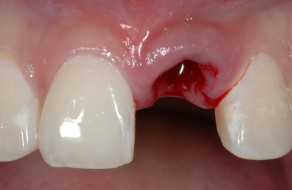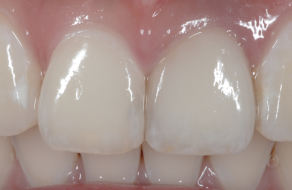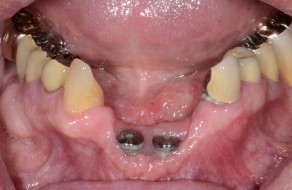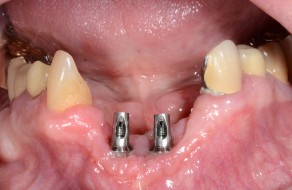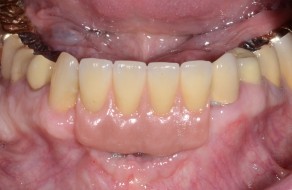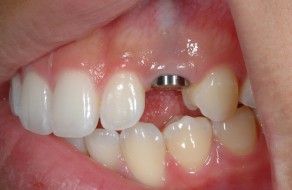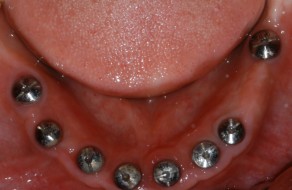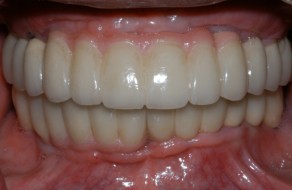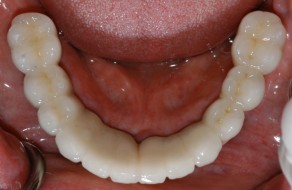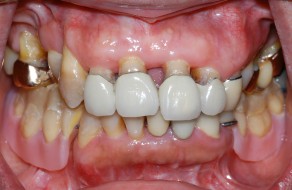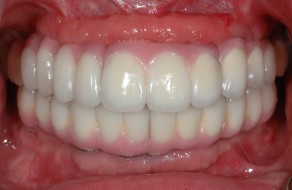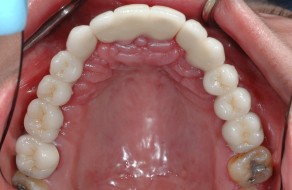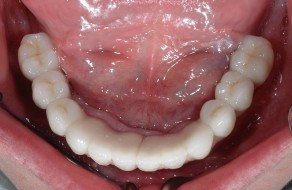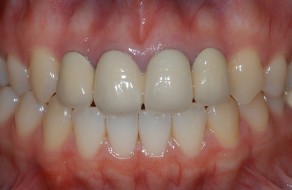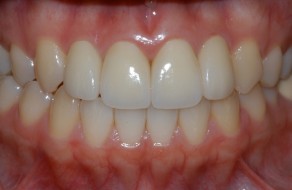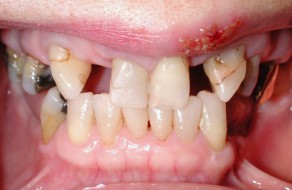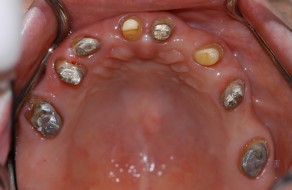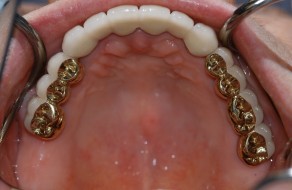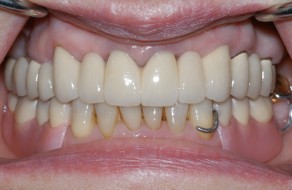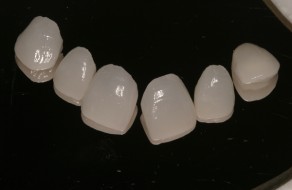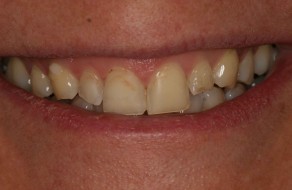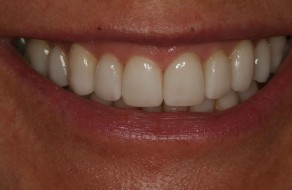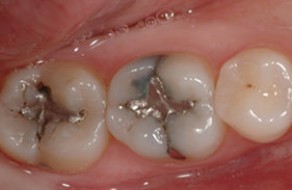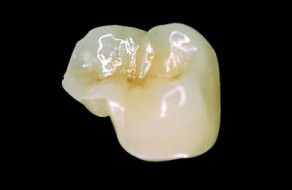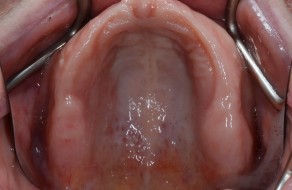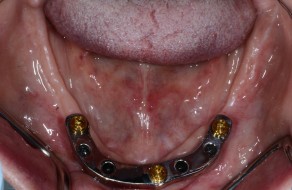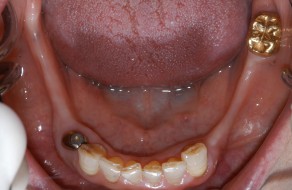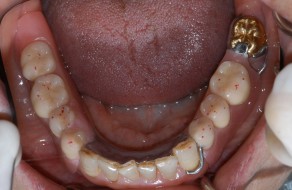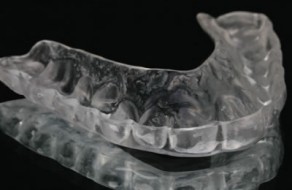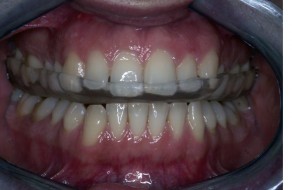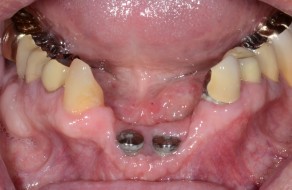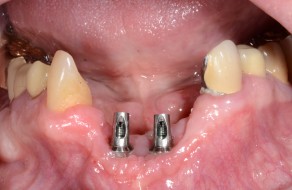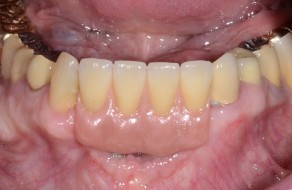Prosthodontic treatment include:
Dental implants
Dental implants are metal cylinders made of titanium surgically placed in the jawbone where teeth are missing. Implants replace the roots of missing teeth and support single crowns, large bridges and dentures. State-of-the-art technology makes it possible for these implant-supported replacement teeth to look, feel and function like natural teeth. There are many types of dental implants and many ways to use dental implants to achieve your goals of a pleasing smile and good chewing function. Visit with Dr. Cheng to find out how dental implants can improve your life.
Full Mouth Reconstruction
People with severe dental problems are candidates for a full mouth reconstruction. As the name implies, full mouth reconstruction refers to rebuilding all of the teeth in a patient’s mouth. Full mouth reconstructions combine esthetics with the science of restorative dentistry to improve the health, function and beauty of the smile. Crowns (caps), dental bridges, dental veneers and/or dental implants may be used in a full mouth reconstruction. In some patients orthodontics may also be employed to help properly position the jaw and align the teeth.
Crowns (caps)
Crowns cover or “cap” a tooth to restore the normal function and appearance of the tooth. Crowns may be made as all metal, porcelain fused to metal or all-ceramic (porcelain). Crowns are indicated for teeth with very large fillings, teeth that have had a root canal, fractured teeth, worn teeth and misshapen and/or discolored teeth.
Bridges
Traditional methods to replace a missing tooth or teeth include the fabrication of dental bridges. To replace a missing tooth with a dental bridge, at least one tooth on either side of the space created by the missing tooth must be prepared for a crown. Then a false tooth is joined to the crowns, and the entire bridge is cemented to the prepared teeth. The patient cannot remove the dental bridge, and special aids are available to keep it clean.
Veneers
Dental veneers are used to modify the shape and color of teeth. Dental veneers are thin shells of porcelain that are etched and then bonded to the enamel of the teeth. Tooth preparation is necessary to avoid over bulking of the tooth, but it is limited to the enamel and usually involves only a few surfaces of the tooth.
Inlays/Onlays
Traditionally, inlays were used instead of fillings to replace a small amount of tooth structure loss due to decay. Like fillings, inlays fit inside the tooth and were made of gold. Today inlays are still used in the same situations, but the inlays are made of a tooth-colored material such as ceramic/porcelain or special dental composite. Defective or unsightly “fillings” can be replaced by tooth-colored inlays and bonded to the tooth. This bonding process may actually improve the strength of the tooth and help seal the inlay to the tooth.
Onlays also fit inside the tooth, but extend onto the chewing surface of a back tooth to replace one or more cusps. In the past onlays were made of gold, but like inlays, more and more patients request a tooth-colored onlay. Making the onlay of ceramic/porcelain provides an esthetic alternative to gold and allows the restoration to be bonded to the tooth. This bonding process may actually improve the strength of the tooth and help seal the onlay to the tooth.
It is difficult to determine when inlays or onlays can be used instead of crowns or caps. Ask Dr. Cheng if you are a candidate for a tooth-colored inlay or onlay.
Complete Removable Dentures
Dentures are removable replacements for missing teeth. Complete dentures replace all teeth and removable partial dentures replace some teeth. By matching each individual’s unique smile and bite, dentures can improve facial appearance and self-confidence. Dentures can also solve pronunciation problems caused by missing teeth and improve chewing.
Removable Partial Dentures
For patients missing several teeth, but not all of their teeth, a removable partial denture may be recommended. This type of denture uses the remaining teeth to hold or anchor the removable bridge in place. There are many different types and designs for removable partial dentures. Typically, a removable partial denture is made of a metal framework with pink plastic to replace the gum tissue and plastic or resin denture teeth. The number of missing teeth and their location will affect the comfort and stability of the removable partial denture. The use of dental implants may increase the stability of a removable partial denture, or dental implants may be the best solution for replacing the missing teeth. Consult Dr. Cheng to determine if a removable partial denture will satisfy your needs. Dr. Cheng can offer you many designs for your removable partial denture or provide other alternatives to consider including dental implant-supported crowns and bridges.
Occlusal Splints/Nightguards
An occlusal splint or orthotic device is a specially designed mouth guard for people who grind their teeth, have a history of TMJ pain and dysfunction or have completed a full mouth reconstruction. An occlusal splint is custom made using detailed study models on an instrument called an articulator that simulates the movement of the jaws. The occlusal splint is made from a processed acrylic resin and is designed to guide the jaw as it moves side to side and front to back. This precise custom orthotic device not only protects the teeth from harmful habits, but it supports the TMJ and the muscles that are used in chewing.
Traumatic injuries to the mouth’s structures
Traumatic injuries often occur in motor vehicle accidents or sports-related injuries. Chipped teeth account for the majority of all dental injuries. Dislodged or knocked-out teeth are examples of less frequent, but more severe injuries. Treatment depends on the type, location and severity of each injury. Any dental injury, even if apparently mild, requires examination immediately. Sometimes, neighboring teeth suffer an additional, unnoticed injury that will only be detected by a thorough dental exam. Prosthodontists are dentists who specialize in treating traumatic dental injuries. With their advanced skills, techniques and technologies they can often save injured teeth. If the tooth cannot be saved , Dr. Cheng will discuss the replacement of the tooth with other treatment options such as dental implant or a bridge.
Congenital or birth anomalies to teeth
Occasionally there are conditions that result in malformed or missing teeth. Some of these conditions are: congenital, meaning present from birth, and some are developmental, meaning they occur as a result of environmental factors during tooth development. Depending on the situation or condition the missing or malformed teeth may present in different locations of one’s mouth. Some of the more common conditions are: congenitally missing teeth, congenitally missing laterals, impacted teeth, ectodermal dysplasia, amelogenesis imperfecta, and dentinogenesis imperfecta. Once the diagnosis has been made, one should seek treatment with properly trained professionals such as a prosthodontist. A prosthodontist has advanced training to help ensure the proper techniques and materials are used to ensure the most predictable long term result for your tooth replacement.[/toggle]
Oral cancer reconstruction and continuing care
Patients with oral cancers treated in their early stages, may have little in the way of post treatment disfigurement. For those whose cancer is caught at a later stage, the results of surgical removal of the disease may require reconstruction of portions of their oral cavity or facial features. There may be adjunctive therapy required to assist in speech, chewing of foods, the problems associated with the lack of salivary function, as well as the fabrication of dental or facial prostheses. Rehabilitation of the head and neck cancer patient requires a team approach, which includes many specialists such as the prosthodontist.


